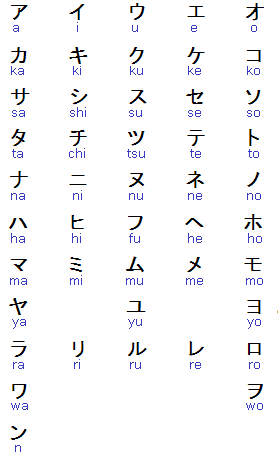Katakana
Around the 9th century, the Japanese developed their own writing system based on syllables: hiragana and katakana (together: kana). Of the two kana systems, hiragana is more cursive, while katakana characters are more angular.
Hiragana and katakana each consist of 46 signs which originally were kanji but were simplified over the centuries. When looking at a Japanese text, one can clearly distinguish the two kinds of signs: the complicated kanji and the simpler kana signs.
Among the syllables are the five vowels (a i u e o). The rest are syllables combined by one of these vowels with a consonant (ka ki ku ke ko ra ri ru re ro...). One exception is the n.
In addition, most syllables can be slightly changed by adding two small strokes or a small circle in the top right corner next to the character. For example, ha changes to ba with the addition of two small strokes, or to pa with the addition of a small circle.

These days, katakana is used mainly for writing loan words and the names of foreign persons and geographical places that cannot be written in kanji.
Questions? Ask in our forum.